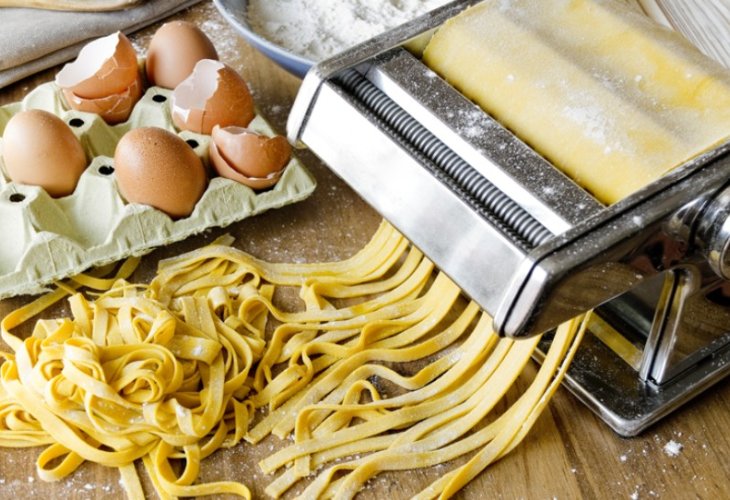Jewish Law
Can Pasta Be Kosher Without Supervision? Hidden Halachic Challenges in Fresh and Imported Pasta
Discover why even plain pasta abroad may require strict kosher certification and why dry pasta isn’t always as simple as it seems
 (Photo: shutterstock)
(Photo: shutterstock)Every summer — and before every vacation season — Jewish travelers who keep kosher are greeted with pamphlets and online guides offering advice on how to eat kosher while traveling abroad. These guides list kosher restaurants, bakeries, and supermarkets across Europe and beyond.
Alongside the lists of certified establishments, these publications often include “safe products” — items that, they claim, may be purchased even without a kosher symbol. One striking example: a long list of noodles and pasta allegedly permissible “even without kosher certification.”
Can pasta really be kosher without supervision?
Not All Pasta Is Created Equal
To answer this, it’s important to clarify that such claims cannot apply to most Israeli-style noodles, which typically contain eggs. Even putting aside concerns about egg freshness (e.g., overnight eggs, additives, or unknown ingredients), in many countries there’s a major kashrut issue with eggs containing blood, especially from fertilized eggs — a Torah-level prohibition, not just a matter of appearance.
Thus, it’s clear these guides refer not to Israeli egg noodles but to Italian-style pasta, like spaghetti — a vast category with over 300 varieties worldwide.
Dry Pasta and Fresh Pasta
Dry Pasta – traditionally made from just flour and water.
Fresh Pasta – usually includes eggs, and is used for products like ravioli, lasagna, and tagliatelle.
The eggs give the pasta its texture and color — from light yellow to deep orange, depending on the yolks.
Fresh pasta presents multiple kashrut challenges, beyond the issue of eggs.
The Problem of Pasteurization and Bishul Akum
Most fresh pasta undergoes a process of pasteurization and cooling, which keeps it fresh and slightly pre-cooked. This raises the question: Who places the pasta in the pasteurization machine? If it’s done by a non-Jew, there may be a problem of bishul akum (food cooked by a non-Jew).
While some kashrut authorities rely on the Rema, who ruled that it is sufficient for a Jew to ignite the flame, or on leniencies regarding steam-cooked foods, others — especially under the Badatz Beit Yosef, following the rulings of Maran the Shulchan Aruch — require that only a Jew insert the pasta into the pasteurizer, even when it operates with steam.
Steam Systems and Cross-Contamination
Industrial pasteurizers often share a steam network across the entire factory. As a result, even plain spaghetti may absorb dairy or cheese residue from the same system if other products — like cheese-filled ravioli — are produced nearby.
This means that unsupervised pasta can easily become dairy.
How Fresh Pasta Is Made (and Why It Matters)
Fresh pasta dough is kneaded by machines equipped with an extruder head (similar to a meat grinder). It forms long sheets of dough rolled into massive coils. These coils are then cut into various pasta shapes.
After cutting, leftover scraps remain — like paper cutouts after tracing a stencil. The scraps are not discarded, but are recycled back into the dough mixer for the next batch.
If the previous batch was cheese-filled ravioli, those scraps contain dairy residue. When recycled into the next product — say, spaghetti — the “plain” pasta becomes halachically dairy, even if unlabeled as such.
The Forgotten Mitzvah: Separating Challah
Recycling dough also creates another halachic question — hafrashat challah (separating dough for the mitzvah of challah).
Dough made only for boiling is generally exempt from challah.
Dough made for baking (like lasagna sheets) is obligated in challah.
When scraps from baked products are recycled into boiled ones, the halachic status becomes mixed. If the original intent was partially for baking, the entire dough — including the pasta, may require hafrashat challah with a blessing.
Unfortunately, many factories do not perform this mitzvah at all, either out of ignorance or oversight.
The Colorful Pasta Problem
It’s clear that the “permissible” pasta mentioned in those guides does not include colored varieties:
Black pasta often contains sepia (squid ink).
Green pasta is made from spinach or other plant additives, often unsupervised and containing artificial colors and flavorings.
Therefore, the only possible type they could be referring to is dry pasta — made simply from flour and water. But even that, as we’ll explore in another article, is not without its complexities.

